[Editor’s Note: This review was updated following publication with updated iPod compatibility details as per Griffin and more specifics on the Mediaguide technology as per Mediaguide; it remains otherwise in its original form.]
Tuesday, January 5, 2010
Griffin iFM Radio Browser
When Griffin Technology released its combination FM radio tuner and remote control Navigate back in April, something was conspicuously missing: Griffin's promised free App Store iPhone and iPod touch application iFM. This week, the app finally became available as iFM Radio Browser 1.1 (Free), and though it's in markedly different form from the pre-release version we'd previously tested, most of the changes the company has made are for the better. Still, some relatively serious issues limit its appeal.




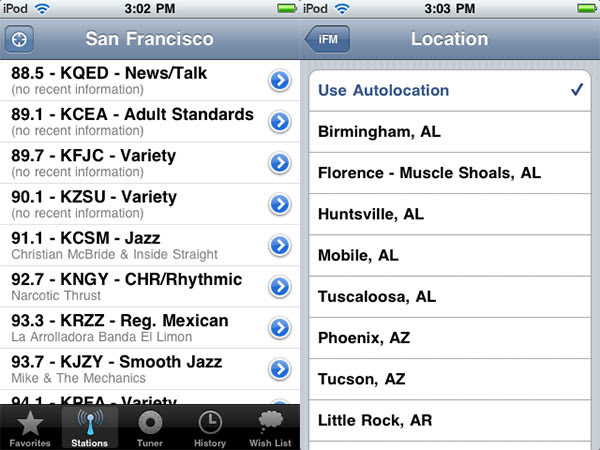
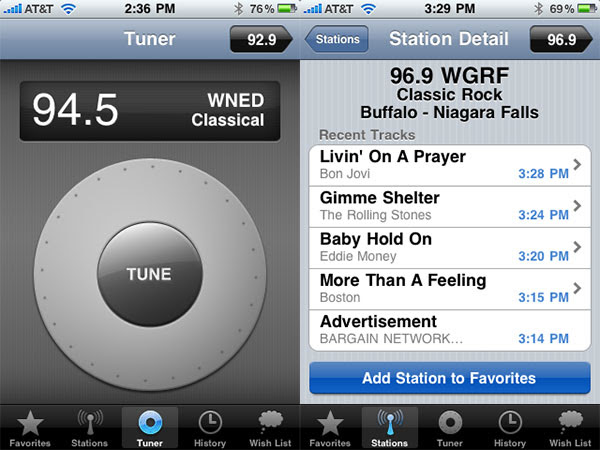

[Editor’s Note: This review was updated following publication with updated iPod compatibility details as per Griffin and more specifics on the Mediaguide technology as per Mediaguide; it remains otherwise in its original form.]
[Editor’s Note: This review was updated following publication with updated iPod compatibility details as per Griffin and more specifics on the Mediaguide technology as per Mediaguide; it remains otherwise in its original form.]
eReader eBook Application
Description:
eReader allows you to read premium eBook content right from your iPhone including top book authors like Stephen King, Mary Higgins Clark, James Patterson, Nora Roberts and many more! It also has the ability to add personal content.
Features:
Read Premium, Unsecured and personal eBooks and electronic documents.
eReader allows you to read premium eBook content right from your iPhone including top book authors like Stephen King, Mary Higgins Clark, James Patterson, Nora Roberts and many more! It also has the ability to add personal content.
Features:
Read Premium, Unsecured and personal eBooks and electronic documents.
Duck Duck Moose Design Old MacDonald
Back in February, we were seriously impressed by a $1 children's educational application called Wheels on the Bus from a company called Duck Duck Moose Design, which managed to create a wonderfully illustrated, interactive book from the classic children's song -- complete with 12 different versions of the song that varied in language, instrumentation, and even the user's ability to customize the song with his or her own voice. Now the company has returned with its second product, Old MacDonald ($2), which preserves the same general formula for a different song.

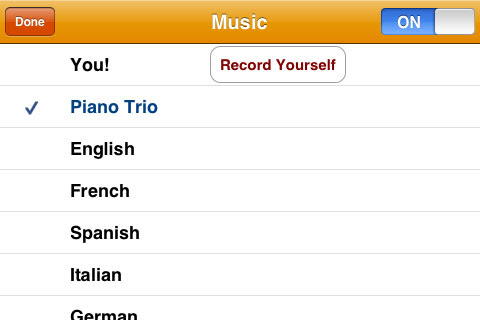






Digiot Pocket Lint
Deskescape Budget
Tapping on a category in the main budget view leads the user to that category’s main screen, which shows a list of recent normal transactions, and features buttons that allow for the setting of that category’s budget, deletion of current transactions, and the addition of new transactions. The add button leads to the new transaction screen, where users can enter an amount, description, date, and notes, while the advanced budget button leads to a screen where users can set up reoccurring payments or income streams, with the ability to add a description, budget, start and end month, day due, and turn reminders and auto actual features on and off.
Design by a knife Pennies
On August 25, 2008, we reviewed a collection of 15 different personal finance applications for the iPhone and iPod touch in a roundup entitled iPhone Gems: Every Personal Finance Application, Reviewed. This review contains a review of one application from that roundup; additional comparative details can be found in the original full story.

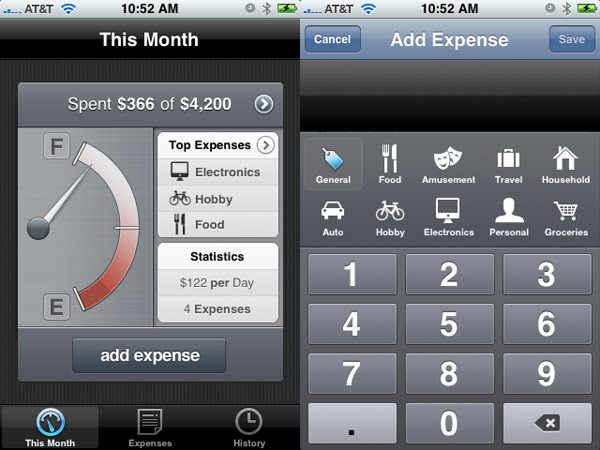
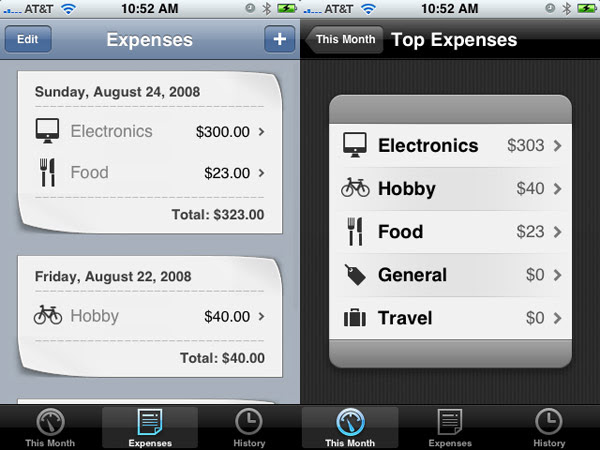
Connor Wakamo Balance
On August 25, 2008, we reviewed a collection of 15 different personal finance applications for the iPhone and iPod touch in a roundup entitled iPhone Gems: Every Personal Finance Application, Reviewed. This review contains a review of one application from that roundup; additional comparative details can be found in the original full story.

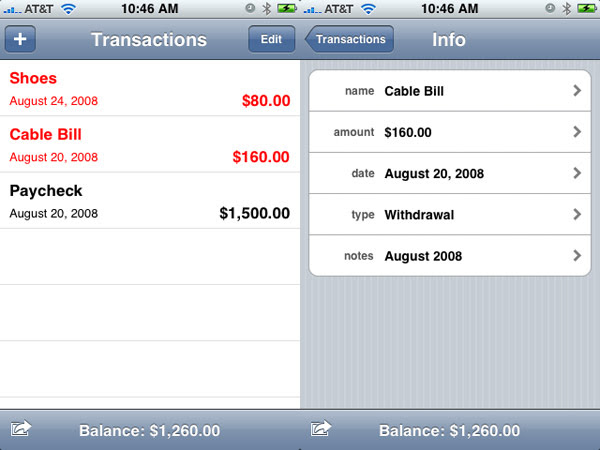
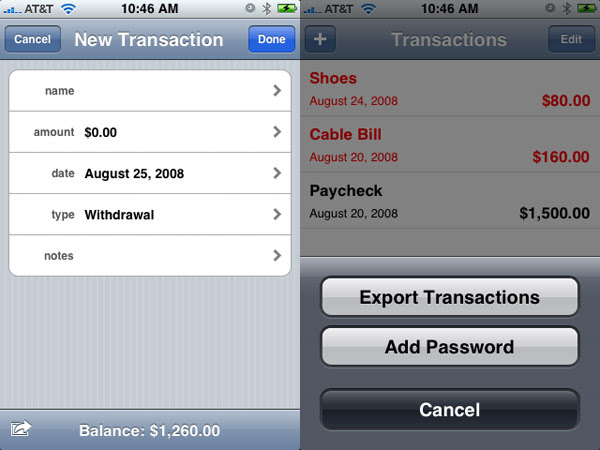
Connected Flow Exposure and Exposure Premium
On August 8, 2008, we reviewed a collection of eight different Flickr applications for the iPhone and iPod touch in a roundup entitled iPhone Gems: Every Flickr Application, Reviewed. This review contains a review of one application from that roundup; additional comparative details can be found in the original full story.

Exposure and Exposure Premium are fairly well-rounded Flickr photo viewers. Both versions of the application offer the same functionality and will be reviewed as one: the free version places small, generally unobtrusive ads at the top of each page, while the Premium version removes these ads.
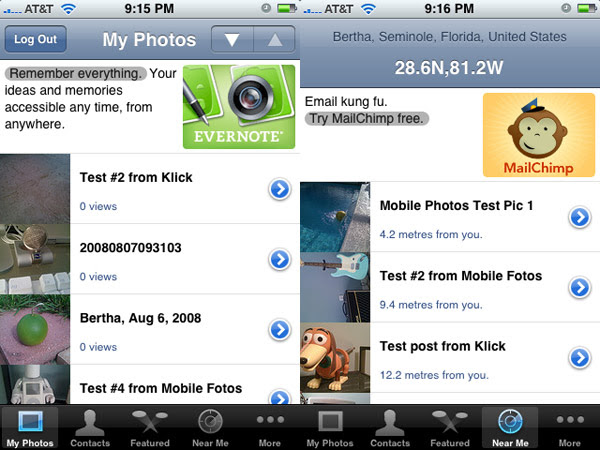


Exposure and Exposure Premium are fairly well-rounded Flickr photo viewers. Both versions of the application offer the same functionality and will be reviewed as one: the free version places small, generally unobtrusive ads at the top of each page, while the Premium version removes these ads.
Connected Flow Exposure and Exposure Premium
On August 8, 2008, we reviewed a collection of eight different Flickr applications for the iPhone and iPod touch in a roundup entitled iPhone Gems: Every Flickr Application, Reviewed. This review contains a review of one application from that roundup; additional comparative details can be found in the original full story.

Exposure and Exposure Premium are fairly well-rounded Flickr photo viewers. Both versions of the application offer the same functionality and will be reviewed as one: the free version places small, generally unobtrusive ads at the top of each page, while the Premium version removes these ads.



Exposure and Exposure Premium are fairly well-rounded Flickr photo viewers. Both versions of the application offer the same functionality and will be reviewed as one: the free version places small, generally unobtrusive ads at the top of each page, while the Premium version removes these ads.
Catamount Software PocketMoney
Having initially been released on the Apple Newton 14 years ago, PocketMoney ($10) from Catamount Software is a finance manager offering management of potentially unlimited financial accounts. Upon launch, users are dropped at a main account screen containing each account previously set up, as well as their balances. An add button permits creation of new accounts, an edit button enables the deletion of accounts, a gear button provides access to the app’s preferences, including toggling the pop-up tips on and off, setting a password, and choosing a currency, and an eye button lets users choose which accounts appear on the main screen and what balance to show, from future, cleared, current, or available balances.



Business Proffessional Ringtones for iPhone
Description:
This is the only collection of ringtones for the iPhone that is appropriate for the workplace!
The creators of this product were tired of the one semi-professional ringtone that shipped with the iPhone.
To solve this problem we created a large collection of iPhone specific ringtones. These are all digitally mastered, recorded, and then tested on the iPhone.
Features:
This package includes:
- A LARGE collection of ringtones.
- NO VOICES, RAPS, BARKS, or MUSIC.
- Perfect for the workplace, getting that promotion or sale.
- No hidden fees, subscriptions, or recurring billing.
- Real ringtones and digitally mastered tones.
This is the only collection of ringtones for the iPhone that is appropriate for the workplace!
The creators of this product were tired of the one semi-professional ringtone that shipped with the iPhone.
To solve this problem we created a large collection of iPhone specific ringtones. These are all digitally mastered, recorded, and then tested on the iPhone.
Features:
This package includes:
- A LARGE collection of ringtones.
- NO VOICES, RAPS, BARKS, or MUSIC.
- Perfect for the workplace, getting that promotion or sale.
- No hidden fees, subscriptions, or recurring billing.
- Real ringtones and digitally mastered tones.
Archibald’s Adventures
Description:
Archibald is an action puzzle game with a lot of features - you start as a boy on skateboard, but soon you will roll in robotic vehicle capable of riding on walls and ceilings, fly on jet device or remotely control mysterious floating bubble able to switch distant mechanism or transport objects.
Archie and crazy Professor Klumpfus are stuck in the professor’s mansion. The latest experiment of the goofy scientist went all wrong, and weird lifeforms escaped from their containment. Now a paranoid central computer locked both heroes up!
Features:
- Go through 114 levels in this mind blowing action puzzle platform game
- Experience innovative gameplay with many unique features of the hero: transportation of objects, riding on walls and ceilings, flying with a jet armchair and more
- Use your wit and fast reaction to avoid nasty dangers of the mad scientist’s mansion
- Use the professor’s device pod to climb the walls or his artificial intelligence matter to solve riddles
- Encounter lots of weird and funny lifeforms running loose in the levels!
Archibald is an action puzzle game with a lot of features - you start as a boy on skateboard, but soon you will roll in robotic vehicle capable of riding on walls and ceilings, fly on jet device or remotely control mysterious floating bubble able to switch distant mechanism or transport objects.
Archie and crazy Professor Klumpfus are stuck in the professor’s mansion. The latest experiment of the goofy scientist went all wrong, and weird lifeforms escaped from their containment. Now a paranoid central computer locked both heroes up!
Features:
- Go through 114 levels in this mind blowing action puzzle platform game
- Experience innovative gameplay with many unique features of the hero: transportation of objects, riding on walls and ceilings, flying with a jet armchair and more
- Use your wit and fast reaction to avoid nasty dangers of the mad scientist’s mansion
- Use the professor’s device pod to climb the walls or his artificial intelligence matter to solve riddles
- Encounter lots of weird and funny lifeforms running loose in the levels!
Apple MobileMe iDisk
hough Apple's MobileMe - a web-based mail, contact, calendar, photo, and now video storage and synchronization service - launched with a series of significant performance problems, the company has spent the last year trying to remedy them, add new features, and placate disenchanted customers. This week, Apple released MobileMe iDisk, a free application for the iPhone and iPod touch, which offers users the ability to access up to 10 Gigabytes of files that were transferred from their computers to Apple's "cloud-based, available anywhere" servers, as well as access to publicly-shared files from their contacts. As with many first-generation MobileMe features, the MobileMe iDisk app has its hiccups, but it does take another step in expanding the service's appeal.

Mac subscribers to MobileMe find iDisk as just another one of the “Devices” on the left side of their Finder windows, initially sitting empty but for a collection of folders with labels such as “Documents,” “Music,” “Pictures,” and “Software.” Drag a file from one folder on your Mac over to either the iDisk icon or one of its sub-folders and, assuming you have a connection to the Internet, you’ll generally see the file transfer over to Apple’s server via that Internet connection. Do this with as many files as you’d like until you reach the limits of iDisk’s storage capacity, and if they’re iPod or iPhone supported movies or videos, iWork, Microsoft Office, or PDF files, you’ll be able to use the MobileMe iDisk app to play them on your iPhone or iPod touch wherever you can get access to the Internet. Most of our files transferred fairly quickly, but we did have a full-on Finder lockup when trying to transfer an PDF file directly from iTunes to iDisk, a real rarity by Mac standards. The same file transferred fine when the machine was rebooted and the file started on the desktop rather than in iTunes.
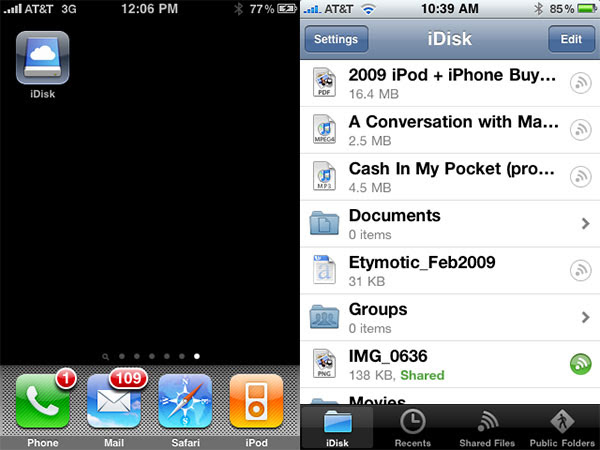
After entering your MobileMe account information into the application, you’ll be presented with a screen-filling list of your files and folders, complete with circular icons that indicate whether individual files are being publicly shared with people or not; anything you drop in the Public folder gets shared with everyone by default, and anything else can be shown to individuals only. Just click on the circular icon and an e-mail window pops up, sending people via e-mail a direct link to the file, which can be viewed with their web browsers. Public folders for your contacts or non-contact individuals can be accessed via a tab at the bottom of the screen, and a list of recently viewed files is maintained for your reference.
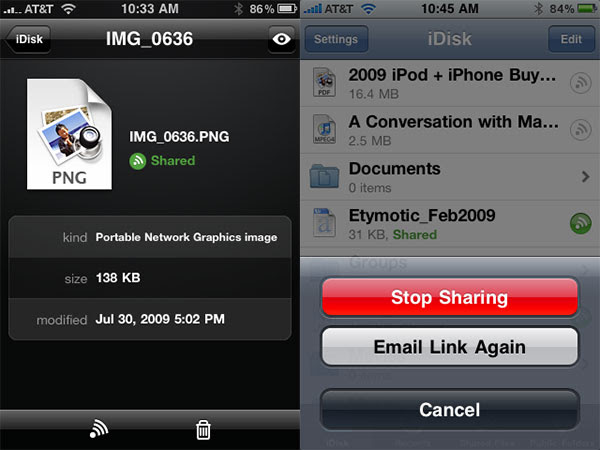
Under ideal circumstances, which we’ve found to be generally the case for music, video, photo, and document files, the only thing you’ll need to be concerned about when using MobileMe iDisk is transfer time. Because the iPhone and iPod touch are wirelessly fetching files from the Internet, Megabyte and multi-Megabyte files may take a minute or so to load, depending on the manner that you’re connecting to MobileMe’s “cloud.” Wi-Fi and iPhone 3GS cellular connections are pretty speedy, generally, but we’ve seen hiccups: one of us was able to get a 17MB PDF file to load quickly over Wi-Fi, but the other had it fail multiple times mid-load, succeeding only on attempt #4 when we monitored the Wi-Fi iPhone 3GS for the 8-minute duration of the load, and prevented its screen from shutting off mid-transfer.

Notably, the application also has an interesting and smart little feature: caching. Using a slider, you can allocate “Local Storage” to the app, enabling it to hold between 50 and 200MB of non-audio, non-video files in its own cache so that you needn’t reload everything when you return to view something a second time. For obvious reasons, this increases the app’s footprint on your device to the extent that files have previously been loaded, but you have control over how much or how little you want to keep around.

Almost everything we tried to play back through the MobileMe iDisk application worked, and smoothly if not beautifully. Music files with embedded album artwork played in a generic QuickTime video player without any visual accompaniment, and video files used the same QuickTime player but obviously performed both video and audio. Notably, the video was not degraded when on a cellular connection, preserving the same quality as the original version rather than introducing artifacted, lower-resolution images as alternatives.
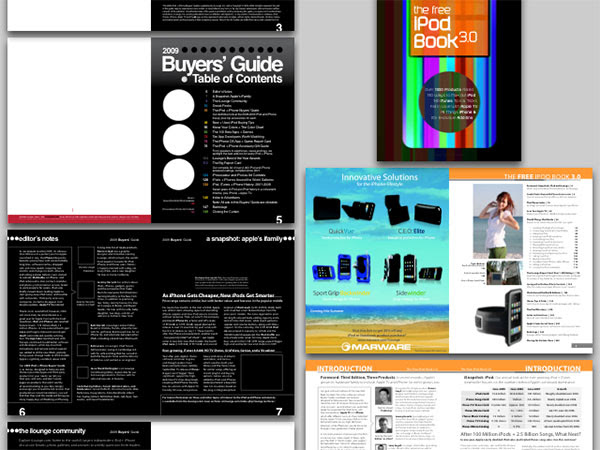
PDF performance wasn’t quite as impressive. In addition to the loading times, we had mixed results with getting PDFs to render properly; some looked perfect, others had glitches such as missing images. And some files, such as contact cards, showed up as nice-looking icons but wouldn’t open.
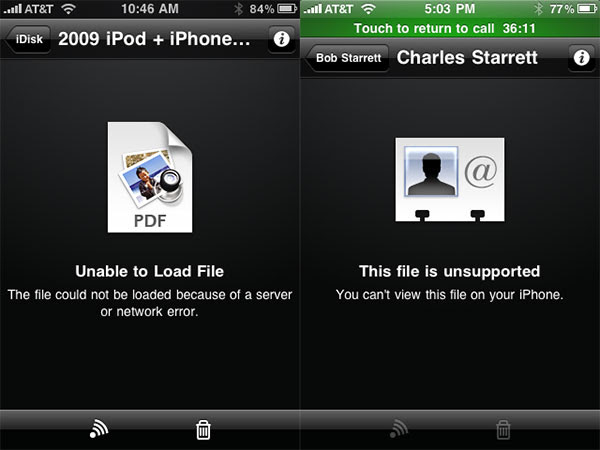
As a free application for MobileMe users, MobileMe iDisk is a nice little program, enabling web-based access to content that you want to share or just not stuff into your iPod’s or iPhone’s limited storage capacity. Apple still has some work left to be done to make the MobileMe environment more reliable on the desktop side, and the performance better on the pocket device side, but what’s here is a good start.
Apple iPhone OS 3.0
Apple's first-generation iPhone OS was revolutionary. Its second-generation version introduced iPhone and iPod touch users to the App Store, which unquestionably was a much bigger hit than even Apple expected, as well as adding Microsoft Exchange support for enterprise users. By comparison, the brand new iPhone OS 3.0 doesn't initially seem to have a single home run feature -- many users will remember it as a consistent base hitter, or "the version that should have shipped with the first iPhone" -- but it actually packs extremely significant under-the-hood improvements, some of which won't be fully appreciated for weeks or months to come.
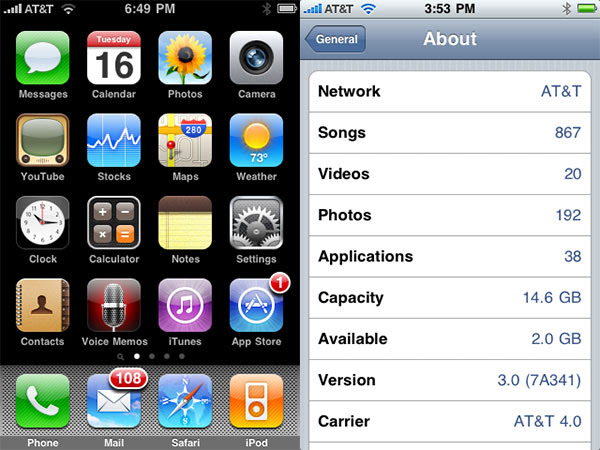
Please note that the list below is not in rank order; it is merely designed to highlight features of special interest to our editors and readership.
1. Spotlight and Search
Though the iPhone’s Home screen remains virtually untouched from earlier versions of the OS, a tiny magnifying glass option at the bottom of the screen clues you in to a new screen that sits off to the left of the main page: swipe over to it and you activate Spotlight, a feature that can search your iPhone’s database—everything from e-mail headers to apps to iPod media—for words you enter into a search field. Spotlight works quickly to show you multiple types of content that are all available to you from a single touch of any of the listing buttons; you can limit the parts of the device it searches using Settings.
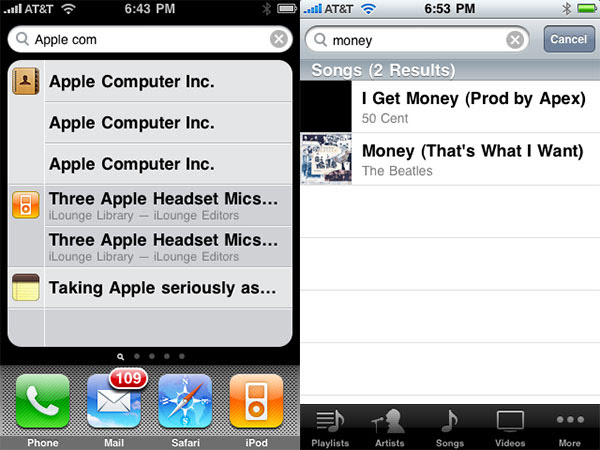
2. Landscape Keyboard
The second major feature addition to iPhone OS 3.0 is widespread landscape keyboard support, which now enables e-mails, text messages, notes, and app-created text to be composed using Apple’s larger, wider keyboard—triggered by turning the device on its side. For the many users who have struggled with the iPhone’s standard vertical keyboard, this larger one may well prove more accurate and easier to use on a daily basis.

3. Cut, Copy, and Paste
One of the most requested additions to the iPhone OS was cut, copy, and paste—effectively, a clipboard system to let users transfer text and images from one application to another, or between two different places in the same application. Apple has implemented this feature with an attractive set of black and blue buttons that pop up when you hold your finger down briefly on the screen in certain applications: the black buttons let you “Cut, Copy, Paste” when the clipboard is empty, or “Select, Select All, Paste” when there’s something stored there, with changes to the button options as appropriate to given apps.
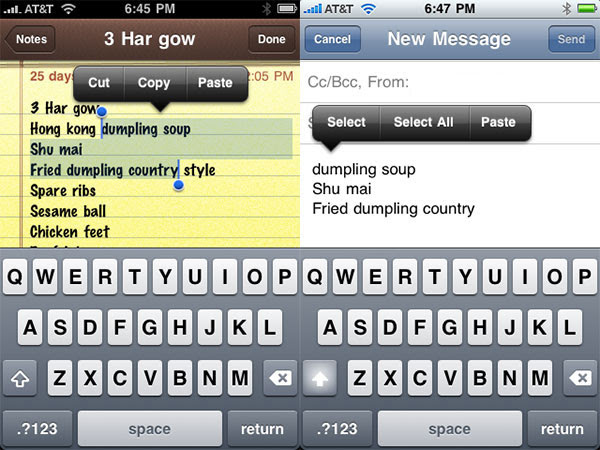
While this feature adds considerable additional power to the iPhone and iPod touch as tools for email and MMS composition, it also creates small interface issues that have come up during our use of iPhone apps. For instance, the black buttons sometimes appear—with a brief delay—when trying to do nothing more than move the cursor. Selection of web page content isn’t as straightforward as one might imagine due to the varied types of content that may be on a page; if you touch a link, for instance, you’re not given the option to copy more of the page’s HTML than that. Apple has made choices here that address the average user’s most common needs, but some additional polish in speed, manner of appearance, and versatility of selection could help cut, copy, and paste feel a little smoother.
4. Voice Memos
Added to the iPhone, iPhone 3G, iPhone 3G S, and iPod touch 2G, the attractive new Voice Memos application allows users to record voice samples from either a built-in or connected microphone, then trim it, e-mail it, or synchronize it back to a computer with iTunes. It presents an image of an old-fashioned microphone with two buttons, one for recording, the other switching between a stop button and a menu button. The menu button calls up a list of prior recordings, allowing you to select any recording to trim it or e-mail it directly on the iPhone. Trimming is the major feature that’s missing from many earlier voice recording applications for the iPhone and iPod touch, and Apple makes it as simple as can be here.
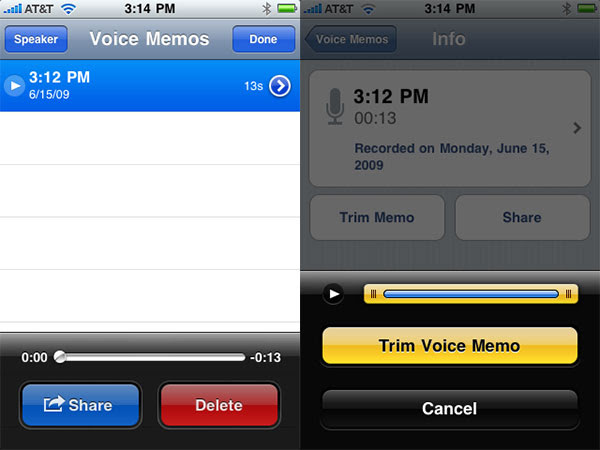
Updated: Note that compatibility of prior stereo microphones varies: Griffin’s iTalk Pro does not appear to work on either the iPhone or iPod touch 2G, while Mikey appears to work on both, as does Tunewear’s stereo recorder; Belkin’s TuneTalk Stereo sometimes works, and sometimes has issues.
5. Multimedia Messaging (MMS)
Available only to iPhone 3G users—and for now, those outside the United States—Multimedia Messaging (MMS) enables an iPhone to send and receive instant messages containing text, photos, audio, and/or video. Because this feature is not currently supported by AT&T, we haven’t been able to properly test it in the United States, but we’ve seen how it works on non-U.S. networks.


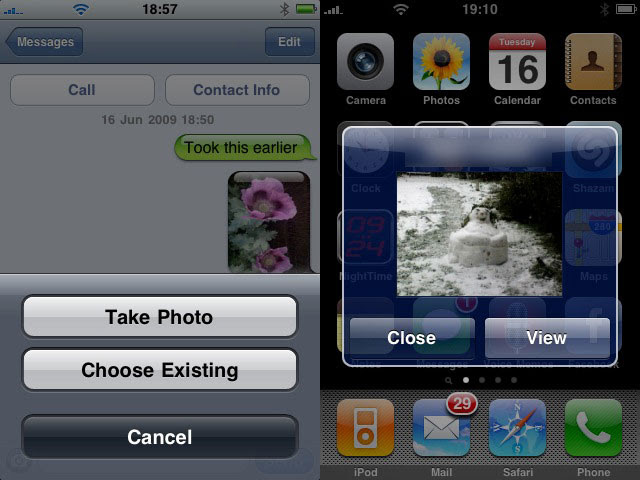

6. Multi-Photo E-mailing and Deletion

7. iTunes Video Downloading
iPhone OS 3.0 expands the capabilities of the mobile iTunes Store application by adding a new Videos tab, complete with sections for Movies, TV Shows, and Music Videos. The limited real estate on the iPhone and iPod touch screens restricts the number of titles spotlighted by the Store, making the Search button considerably more important if you want to find something that isn’t currently being featured. You’ll also need enough storage space to hold the file in its entirety, as well as a sense of how big the video is: if it’s over 10 Megabytes in size, you’ll only be able to download over a Wi-Fi network; if it’s less than that, you can grab the video over 3G.
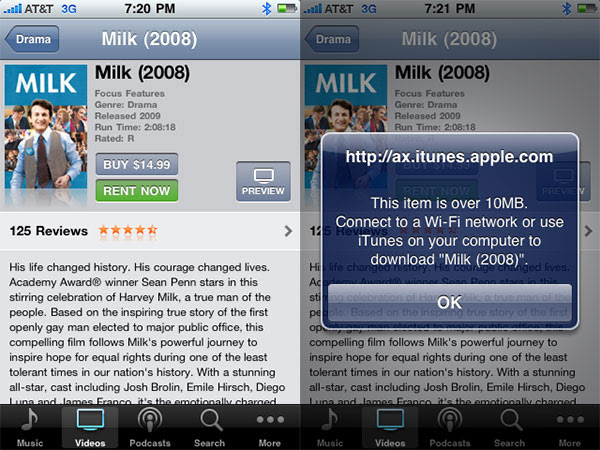
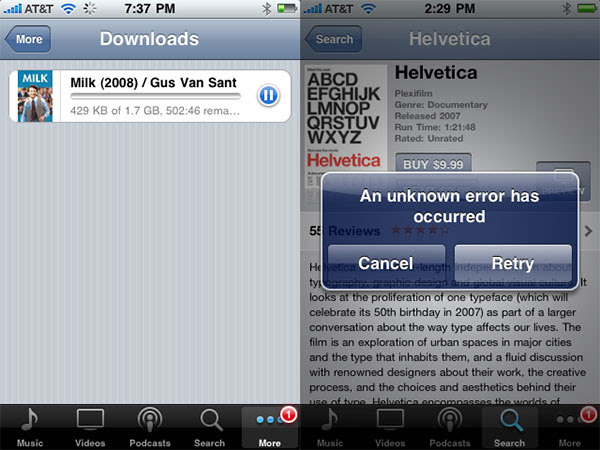
8. Stereo Bluetooth Streaming
Stereo Bluetooth streaming enables the iPhone 3G, iPhone 3G S and iPod touch 2G to send their app and iPod audio—from music, podcasts, and videos—over the air to a wide range of wireless stereo earphones and speaker systems. Notably, their integrated track-changing controls do not appear to be supported by iPhone OS 3.0; Apple’s devices merely send very good-sounding audio directly to the headsets and speakers, and allow that audio to be interrupted for lower-fidelity phone calls or play/pause commands, nothing more.
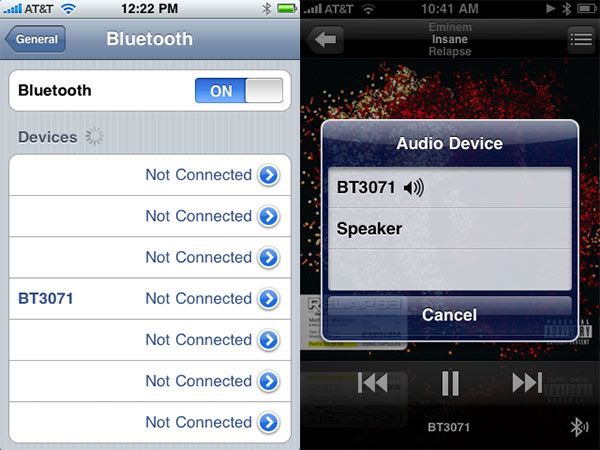
9. Snappier General Performance, with Offsets
Though it’s hard to quantify, iPhone OS 3.0 feels a little more responsive than its predecessors when it comes to certain tasks: snapping pictures, opening Safari pages, and loading certain apps all seemed to be a little faster, though the specific improvements were sometimes difficult to quantify. Some of the web pages we loaded over Wi-Fi on a 2.2.1 iPhone loaded just as quickly as on a 3.0 iPhone 3G; others loaded faster on the new iPhone. iPhone OS 3.0 is a little quicker at taking still images than before, and appears to be a little better at producing sharpened, higher-contrast snaps of black text on white paper. Lens differences or software, we’re not 100% certain, but we think it’s the software.

10. Restrictions (aka Parental Controls)
Though increased Restrictions mightn’t initially seem like a positive feature of the iPhone OS 3.0, this feature—also known as Parental Controls—enables parents to hand off iPhones and iPod touches to kids with less fear that they’ll be misused in some way. In iPhone OS 2.0, Restrictions was limited to six items: on and off switches for Safari, YouTube, iTunes, Camera, installing apps, and viewing Explicit-labeled iPod content. Now the feature has been expanded.
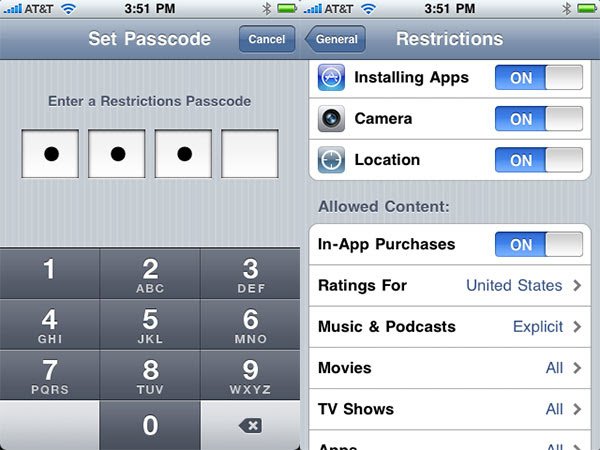
What Else: Push Notifications, Tethering, Find My iPhone, Safari AutoFill & More
One exciting feature of the iPhone OS 3.0 that users have not really seen in full swing quite yet is Apple’s new Push Notifications system, which lets users avoid running multiple apps at the same time, eating battery life in the process. Rather than keeping a news reader or instant messaging application open, waiting for new content to appear, this feature lets you close the application and have a message of some sort—text, a small badge, or a sound—appear on your iPod or iPhone whenever something new comes through. In text form, whatever you’re doing on the iPhone will be interrupted by a notification, just like receiving a text message in prior versions of the iPhone OS.
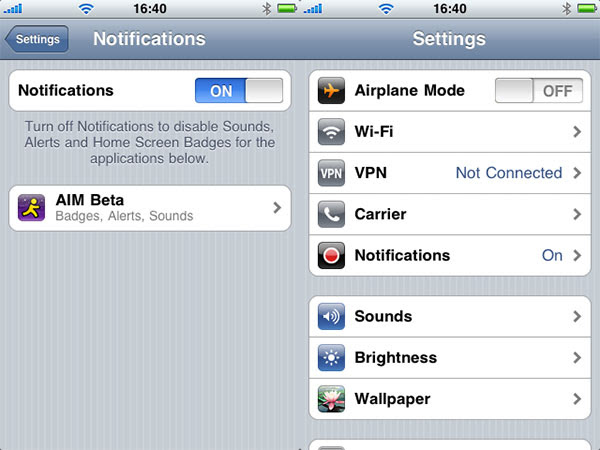
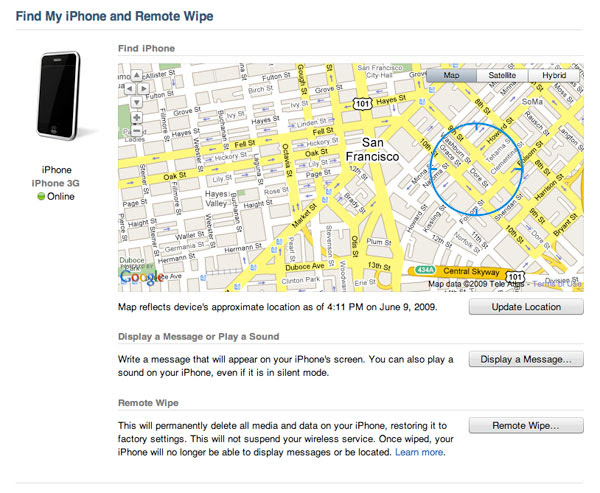
Penultimately, there are also a number of features that fully require implementation by third-party iPhone developers, including In-App Purchasing, in-app playback of iPod music, and many, many more. These iPhone OS 3.0-specific additions are noted in our Complete Guide to iPhone OS 3.0, and their impact won’t be fully appreciated until applications begin to appear with the features in place.
iPhone 3G S Features
Without going into great detail, iPhone OS 3.0 also includes software features that are—for the time being—only accessible to iPhone 3G S users. They include:
Accessibility. New accessibility features are supposed to enable the iPhone 3G S to magnify the screen with up to five times normal zoom, flip the display to white on black for higher readability, and activate spoken VoiceOver reading of on-screen content, plus new gestures to control the iPhone in VoiceOver mode. It’s unclear why these features are not offered on prior iPhones and iPod touch devices.
Voice Control. This feature enables phone dialing and iPod music playback to be controlled through voice commands, apparently requiring additional processing power found in the iPhone 3G S. A special Voice Control application is used to power this feature.
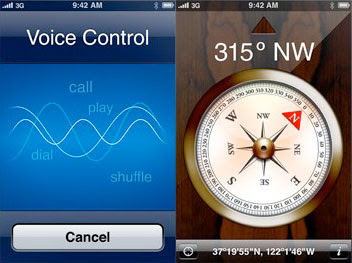
Video Recording and Still Image Autofocus. iPhone 3G S’s Camera application now toggles between still and video recording modes, supporting an autofocus 3-Megapixel still camera and a 640x480 video camera, both major enhancements to the existing iPhone and iPhone 3G camera hardware.
Nike+ Support. iPhone 3G S gains the Nike+ functionality that was added to the iPod touch 2G but omitted from the iPhone 3G and original iPod touch.
Please note that the list below is not in rank order; it is merely designed to highlight features of special interest to our editors and readership.
1. Spotlight and Search
Though the iPhone’s Home screen remains virtually untouched from earlier versions of the OS, a tiny magnifying glass option at the bottom of the screen clues you in to a new screen that sits off to the left of the main page: swipe over to it and you activate Spotlight, a feature that can search your iPhone’s database—everything from e-mail headers to apps to iPod media—for words you enter into a search field. Spotlight works quickly to show you multiple types of content that are all available to you from a single touch of any of the listing buttons; you can limit the parts of the device it searches using Settings.
2. Landscape Keyboard
The second major feature addition to iPhone OS 3.0 is widespread landscape keyboard support, which now enables e-mails, text messages, notes, and app-created text to be composed using Apple’s larger, wider keyboard—triggered by turning the device on its side. For the many users who have struggled with the iPhone’s standard vertical keyboard, this larger one may well prove more accurate and easier to use on a daily basis.
3. Cut, Copy, and Paste
One of the most requested additions to the iPhone OS was cut, copy, and paste—effectively, a clipboard system to let users transfer text and images from one application to another, or between two different places in the same application. Apple has implemented this feature with an attractive set of black and blue buttons that pop up when you hold your finger down briefly on the screen in certain applications: the black buttons let you “Cut, Copy, Paste” when the clipboard is empty, or “Select, Select All, Paste” when there’s something stored there, with changes to the button options as appropriate to given apps.
While this feature adds considerable additional power to the iPhone and iPod touch as tools for email and MMS composition, it also creates small interface issues that have come up during our use of iPhone apps. For instance, the black buttons sometimes appear—with a brief delay—when trying to do nothing more than move the cursor. Selection of web page content isn’t as straightforward as one might imagine due to the varied types of content that may be on a page; if you touch a link, for instance, you’re not given the option to copy more of the page’s HTML than that. Apple has made choices here that address the average user’s most common needs, but some additional polish in speed, manner of appearance, and versatility of selection could help cut, copy, and paste feel a little smoother.
4. Voice Memos
Added to the iPhone, iPhone 3G, iPhone 3G S, and iPod touch 2G, the attractive new Voice Memos application allows users to record voice samples from either a built-in or connected microphone, then trim it, e-mail it, or synchronize it back to a computer with iTunes. It presents an image of an old-fashioned microphone with two buttons, one for recording, the other switching between a stop button and a menu button. The menu button calls up a list of prior recordings, allowing you to select any recording to trim it or e-mail it directly on the iPhone. Trimming is the major feature that’s missing from many earlier voice recording applications for the iPhone and iPod touch, and Apple makes it as simple as can be here.
Updated: Note that compatibility of prior stereo microphones varies: Griffin’s iTalk Pro does not appear to work on either the iPhone or iPod touch 2G, while Mikey appears to work on both, as does Tunewear’s stereo recorder; Belkin’s TuneTalk Stereo sometimes works, and sometimes has issues.
5. Multimedia Messaging (MMS)
Available only to iPhone 3G users—and for now, those outside the United States—Multimedia Messaging (MMS) enables an iPhone to send and receive instant messages containing text, photos, audio, and/or video. Because this feature is not currently supported by AT&T, we haven’t been able to properly test it in the United States, but we’ve seen how it works on non-U.S. networks.
6. Multi-Photo E-mailing and Deletion
7. iTunes Video Downloading
iPhone OS 3.0 expands the capabilities of the mobile iTunes Store application by adding a new Videos tab, complete with sections for Movies, TV Shows, and Music Videos. The limited real estate on the iPhone and iPod touch screens restricts the number of titles spotlighted by the Store, making the Search button considerably more important if you want to find something that isn’t currently being featured. You’ll also need enough storage space to hold the file in its entirety, as well as a sense of how big the video is: if it’s over 10 Megabytes in size, you’ll only be able to download over a Wi-Fi network; if it’s less than that, you can grab the video over 3G.
8. Stereo Bluetooth Streaming
Stereo Bluetooth streaming enables the iPhone 3G, iPhone 3G S and iPod touch 2G to send their app and iPod audio—from music, podcasts, and videos—over the air to a wide range of wireless stereo earphones and speaker systems. Notably, their integrated track-changing controls do not appear to be supported by iPhone OS 3.0; Apple’s devices merely send very good-sounding audio directly to the headsets and speakers, and allow that audio to be interrupted for lower-fidelity phone calls or play/pause commands, nothing more.
9. Snappier General Performance, with Offsets
Though it’s hard to quantify, iPhone OS 3.0 feels a little more responsive than its predecessors when it comes to certain tasks: snapping pictures, opening Safari pages, and loading certain apps all seemed to be a little faster, though the specific improvements were sometimes difficult to quantify. Some of the web pages we loaded over Wi-Fi on a 2.2.1 iPhone loaded just as quickly as on a 3.0 iPhone 3G; others loaded faster on the new iPhone. iPhone OS 3.0 is a little quicker at taking still images than before, and appears to be a little better at producing sharpened, higher-contrast snaps of black text on white paper. Lens differences or software, we’re not 100% certain, but we think it’s the software.
10. Restrictions (aka Parental Controls)
Though increased Restrictions mightn’t initially seem like a positive feature of the iPhone OS 3.0, this feature—also known as Parental Controls—enables parents to hand off iPhones and iPod touches to kids with less fear that they’ll be misused in some way. In iPhone OS 2.0, Restrictions was limited to six items: on and off switches for Safari, YouTube, iTunes, Camera, installing apps, and viewing Explicit-labeled iPod content. Now the feature has been expanded.
What Else: Push Notifications, Tethering, Find My iPhone, Safari AutoFill & More
One exciting feature of the iPhone OS 3.0 that users have not really seen in full swing quite yet is Apple’s new Push Notifications system, which lets users avoid running multiple apps at the same time, eating battery life in the process. Rather than keeping a news reader or instant messaging application open, waiting for new content to appear, this feature lets you close the application and have a message of some sort—text, a small badge, or a sound—appear on your iPod or iPhone whenever something new comes through. In text form, whatever you’re doing on the iPhone will be interrupted by a notification, just like receiving a text message in prior versions of the iPhone OS.
Penultimately, there are also a number of features that fully require implementation by third-party iPhone developers, including In-App Purchasing, in-app playback of iPod music, and many, many more. These iPhone OS 3.0-specific additions are noted in our Complete Guide to iPhone OS 3.0, and their impact won’t be fully appreciated until applications begin to appear with the features in place.
iPhone 3G S Features
Without going into great detail, iPhone OS 3.0 also includes software features that are—for the time being—only accessible to iPhone 3G S users. They include:
Accessibility. New accessibility features are supposed to enable the iPhone 3G S to magnify the screen with up to five times normal zoom, flip the display to white on black for higher readability, and activate spoken VoiceOver reading of on-screen content, plus new gestures to control the iPhone in VoiceOver mode. It’s unclear why these features are not offered on prior iPhones and iPod touch devices.
Voice Control. This feature enables phone dialing and iPod music playback to be controlled through voice commands, apparently requiring additional processing power found in the iPhone 3G S. A special Voice Control application is used to power this feature.
Video Recording and Still Image Autofocus. iPhone 3G S’s Camera application now toggles between still and video recording modes, supporting an autofocus 3-Megapixel still camera and a 640x480 video camera, both major enhancements to the existing iPhone and iPhone 3G camera hardware.
Nike+ Support. iPhone 3G S gains the Nike+ functionality that was added to the iPod touch 2G but omitted from the iPhone 3G and original iPod touch.
Subscribe to:
Posts (Atom)
Asmaul Husna 99 Beautiful Names of Allah
